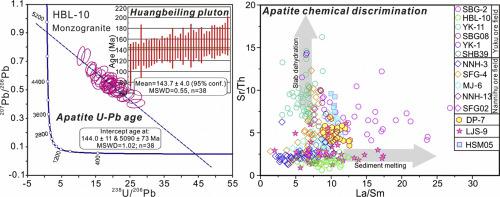Our official English website, www.x-mol.net, welcomes your
feedback! (Note: you will need to create a separate account there.)
Apatite geochronology and chemistry of Luanchuan granitoids in the East Qinling Orogen, China: Implications for petrogenesis, metallogenesis and exploration
Lithos ( IF 2.9 ) Pub Date : 2020-12-01 , DOI: 10.1016/j.lithos.2020.105797 Fan Yang , M. Santosh , Stijn Glorie , Fei Xue , Shuai Zhang , Xuhuang Zhang
Lithos ( IF 2.9 ) Pub Date : 2020-12-01 , DOI: 10.1016/j.lithos.2020.105797 Fan Yang , M. Santosh , Stijn Glorie , Fei Xue , Shuai Zhang , Xuhuang Zhang

|
Abstract The Luanchuan granitoids in the East Qinling Orogen, Central China host multiple genetic types of Mo-W-Pb-Zn-Ag polymetallic deposits. Here we present results from systematic geochronological and geochemical investigations on apatite with a view to gain insights into the petrogenesis, metallogenesis and potential for mineral exploration. We analyzed 388 apatite grains from eight Late Mesozoic granitic plutons in the Luanchuan ore district. Apatite U–Pb geochronology yields 206Pb/238U mean ages in the range of 151.5–102.3 Ma, representing the crystallization ages. Through integrating our results with those from previous studies on the multi-stage magmatism (160–130 Ma; 111–108 Ma) and metallogeny (150–139 Ma; 138–135 Ma; 114 Ma), the newly obtained apatite ages can be correlated with coeval magmatic and metallogenetic events of this ore district. In comparison, except for the Nannihu pluton which is ca. 19 Ma younger than the corresponding zircon U–Pb ages, the other studied plutons show almost consistent apatite and zircon U–Pb ages within error ranges, suggesting rapid post magmatic cooling below ~450 °C in response to shallow emplacement. Apatite chemistry displays ΣREE concentrations in the range of 2379–15,925 ppm, characterized by rather high LREE concentrations, depleted to flat HREE profiles and distinctive negative Eu anomalies, suggesting crust-mantle mixing in the magma source prior to apatite crystallization, which incorporated different degrees of sediment melting and slab melting components triggered by the subducted Paleo-Pacific slab-derived fluids. In conjunction with element concentrations and ratios (e.g., Sr, Mn, Cl, Y, La/Y, Eu/Eu*, (Sm/Nd)N, (La/Sm)N, (Eu/Eu*)N, (Ce/Ce*)N, (La/Yb)N) in apatite, the Luanchuan granitoids are classified as moderately oxidized and mineralized I-type granites. We suggest that the Huangbeiling pluton and other igneous rocks in its vicinity likely have relatively higher potential for future W-Mo/Mo-W exploration, and that different degrees of magmatic differentiation might have generated the porphyry-skarn Mo–W deposit in the Yuku ore field. Moreover, our study also demonstrates that the apatite REE concentrations and ratios can be used as potential indicators for mineral exploration.
更新日期:2020-12-01











































 京公网安备 11010802027423号
京公网安备 11010802027423号